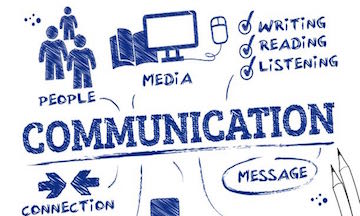
Communication Skills,
Systems, and Plan
Everybody talks about communication problems and no body does anything about it, we therefore remain disconnected. Hugh Ballou

 Get it on Stitcher HERE
Get it on Stitcher HERE
This Podcast Sponsored by Wordsprint
Stay connected with your tribe!
Get Hugh’s Mini-Course on the 5 Pillars of Success for only $9
 Hugh Ballou
Hugh BallouThe Podcast Transcript:
Everybody talks about poor communication, but few do anything about it. – Hugh Ballou
Communication is a Leadership Skill

Healthy organizations have healthy communication systems. The systems do not happen automatically, but with a lot of planning and evaluation and changes to allow the plan to fit the particular organizations. One size does not fit all!
Healthy communication systems fall into the following categories:
- Communication Skills: Defining the skills that leaders need to be effective communicators
- Communication Systems: Defining how communication flows and to whom
- Communication Plan: Defining the communication for specific programs, events, and/or campaigns.
Communication Skills
Having the best communication system in the world will not work unless the members are skilled in basic communication skills. One reason that the majority of organizations recognize communication as a major issue is two-fold: first, there is no thought-out plan and, second, the people do not have basic skills necessary to ensure effective communication. A program of communication skills training should be included in every leadership training program. The following list of skills is only a beginning for discovering the skills necessary to promote and maintain a healthy communication program.
- Personal connection
- Speak directly to the person
- Arrange a time for delivering important messages, don’t catch someone on the fly
- Deliver sensitive messages privately
- Use email only to communicate facts; deliver criticism or sensitive information in person, never use email for negative messages
- Always be respectful
- People do not care how much you know until they know how much you care – show that you care
- Choose words thoughtfully – use “please”, “would you consider,” etc., and stay away from “you have to understand,” etc.
- Look directly at the other person
- Have a positive tone and physical stance
- Be clear and concise
- Ask “was that clear?” and wait for a response
- Get directly to the point and use fewer rather than more words
- Use words that clearly deliver the message
- Be inclusive
- Consider who needs to know and what they need to know
- Deliver the same message to everyone
- Build consensus
- Allow for input from those you communicate to
- Ask for and receive feedback
- Consider other perspectives
- If you ask for an opinion, then receive the opinion without being defensive
- Listen
- Allow for silence when the other person has finished speaking for clarity
- Do not be thinking of your response before the other person has finished talking – listen to the entire message
- Maintain eye contact
- Ask questions or comment for clarity and to validate that you heard correctly
Communication Systems
Defining a healthy communication system is the first step. After the system is defined, then, and only then, can a communication plan be developed to fit into the system. The system has three parts: 1. Specific Messages; 2. Channels of Communication; and 3. Who needs to Know – target groups!
Specific Messages
The messages themselves need to be very specific and complete – what, when, where, sometimes: who and why. There are two kinds of messages, one-way and two-way. Each has a different function and carries a different message. Be sure not to confuse the two functions.
One-way messages keep the community informed and aligned on specific activities, functions, and projects. It is essential to keep members up to date on current activities and facts. This builds support and groups energy for the organization. This is not interactive communication. It is informational communication. Examples of one-way communications are date and time announcements for concerts, meetings, fellowship activities, etc., updates on projects, financial updates, and updates on operations such as search committees, construction, financial campaigns, and recruitment programs.
Two-way messages encourage input and dialogue from a specific target group. This builds community and ownership for projects and campaigns. More complex issues need two-way conversations and dialogue such as vision and value formation, financial planning and evaluation, program evaluation and revision, and volunteer recruitment.
Never use email for two-way dialogue. Some people are not comfortable with computers. Some personalities use the opportunity for personal needs and indirect criticism. Email feedback gives opportunities for and actually empowers passive-aggressive behavior. The same rule applies to surveys. Getting input on issues is an opportunity to engage members in process and build relationships. It is an opportunity for education and ministry for leaders.
Using focus groups to gain support and get feedback is far more effective than surveys, anyway. Developing a strong program for focus groups will strengthen any organization by connecting members as stakeholders and flushing out potential leaders.
Empower healthy behavior and create healthy systems.
Summary of the two types of specific messages:
- One-way messages
- Informational
- No need or opportunity for discussion
- Meeting dates and times
- Project updates
- Financial issues
- Operations updates
- Two-way messages
- Invite dialogue
- Complex and not easy to talk about
- Vision
- Values
- Strategic issues
Practical solution finding
- Channels of Communication
- Personal Channels
- Events
- Staff meetings
- Committee meetings
- Board meetings
- Organizational meetings
- Called meetings
- Personal relationships and conversations
- System Channels
- Website
- Newsletter
- Flyers
- External Media
- Signage
- Personal Channels
- Who needs to Know
- Internal Target Groups
- Employees (be specific)
- Members
- Board
- Committees
- Management
- Projects or groups
- Different departments
- Geographic areas
- External Target Groups
- Media
- Other similar organizations
- Organizations: civic, service, etc.
- Government: libraries, schools, legislature
- Community leaders
- Other nonprofits
Communication Plan
An effective communication plan is essential for every program in the organization. For example, when a planning meeting or a long-range plan or strategic plan is concluding, take time to identify the specific messages from that session. Many groups overlook this item because they think it is obvious or they don’t think about this detail. In the absence of information, members make up their own information, which is typically incorrect. So why not give them the correct information?
Distributing the specific messages to the correct people builds trust and creates ownership for projects and campaigns, such as strategic planning or a financial campaign.
It is important to identify the specific message and, then, who needs to know. Don’t let the process die here. Identify who will send the message and how they will do it. Distinguish messages that are confidential and must stay within the group and messages that need to be distributed internally and externally with the target audience identified.
The intentionality of planning communications will not only save time, prevent duplicated or overlooked tasks and hurt feelings (for those feeling left out of the process), it will create interest and synergy within the membership for the process or campaign.
The key components of a communication plan are as follows:
- Specific Message
- Who Needs to Know?
- Who Will Tell Them?
- How Will They Tell Them?
- When Will They Tell Them?
Resources
Communication Plan Template: http://www.hughballou.com/CommunicationPlan.pdf
Publicity Article: http://www.hughballou.com/DesigningKillerPublicity.pdf
Publicity Templates (PSA, Press Release): http://www.hughballou.com/Publicity.pdf
Creating and Sustaining Healthy Teams: http://www.theleaderaccelerator.com/healthy-teams/
Hugh Ballou
The Transformational Leadership Strategist TM
Subscribe to The Transformational Leadership Strategist by Email



